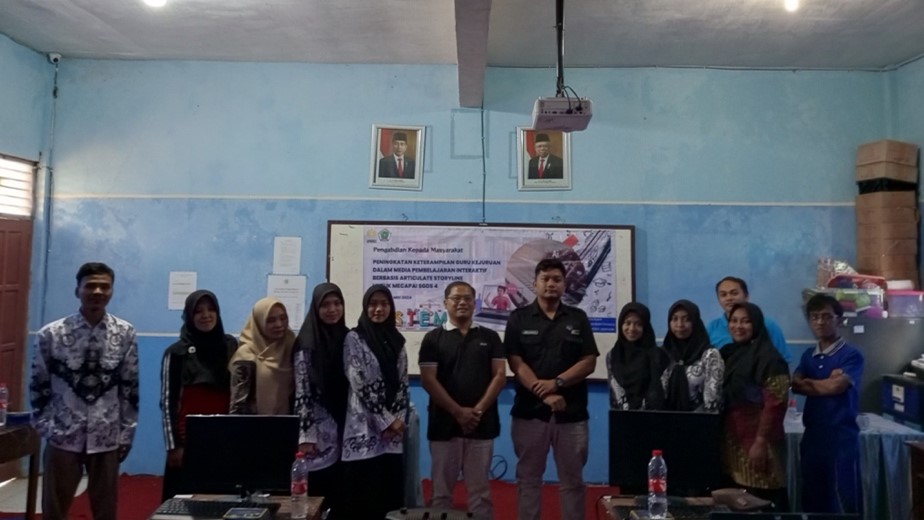Workshop Pembelajaran Untuk Meningkatkan Keterampilan Guru Kejuruan Dengan Articulate Storyline
##plugins.themes.academic_pro.article.main##
Abstract
Kualitas pembelajaran harus terus ditingkatkan melalui pengembangan sumber daya yang terampil. Guru yang memiliki wawasan dalam pengembangan media pembelajaran memiliki potensi untuk mengembangkan pembelajaran ke arah lebih baik. Metode pelaksanaan poengabdian ini dilaksanakan dengan tahapan persiapan, pelaksanaan, dan evaluasi. Hasil kegiatan menunjukan bahwa guru sangat antusias dalam mengikuti workshop media pembelajaran interaktif dengan menggunakan Articulate Storyline. Kegiatan peningkatan signifikan dalam keterampilan peserta, yang sekarang mampu membuat konten pembelajaran yang lebih menarik dan interaktif. Harapanya tidak berakhir pada sesi workshop, guru dapat mengimplementasikan dalam pembelajaran di kelas untuk pembelajaran yang lebih baik.
##plugins.themes.academic_pro.article.details##

This work is licensed under a Creative Commons Attribution-NonCommercial 4.0 International License.
JURPIKAT (Jurnal Pengabdian Kepada Masyarakat) accepts manuscripts that have not been published elsewhere and are not under consideration for publication by other print or electronic media. Authors retain copyright and grant the journal right of first publication with the work simultaneously licensed under a Creative Commons BY-NC License that allows others to share the work with an acknowledgment of the work's authorship and initial publication in this journal.
Authors are able to enter into separate, additional contractual arrangements for the non-exclusive distribution of the journal's published version of the work (eg, post it to an institutional repository, in a journal or publish it in a book), with an acknowledgment of its initial publication in this journal.
License to Publish
The non-commercial use of the article will be governed by the Attribution-NonCommercial 4.0 International (CC BY-NC 4.0). The author hereby grants JURPIKAT (Jurnal Pengabdian Kepada Masyarakat) an exclusive publishing and distribution license in the manuscript include tables, illustrations or other material submitted for publication as part of the manuscript (the “Articleâ€) in print, electronic and all other media (whether now known or later developed), in any form, in all languages, throughout the world, for the full term of copyright, and the right to license others to do the same, effective when the article is accepted for publication. This license includes the right to enforce the rights granted hereunder against third parties.
References
Brill, J. M., & Galloway, C. (2007). Perils and promises: University instructors’ integration of technology in classroom-based practices. . British Journal of Educational Technology, 38(1), 95–105.
Bruggeman, B., Tondeur, J., Struyven, K., Pynoo, B., Garone, A., & Vanslambrouck, S. (2021). Experts speaking: Crucial teacher attributes for implementing blended learning in higher education. The Internet and Higher Education, 48, 100772. https://doi.org/10.1016/j.iheduc.2020.100772
El Sadik, A., & Al Abdulmonem, W. (2021). Improvement in Student Performance and Perceptions through a Flipped Anatomy Classroom: Shifting from Passive Traditional to Active Blended Learning. Anatomical Sciences Education, 14(4), 482–490. https://doi.org/10.1002/ase.2015
GÜVENÇ, G. (2018). The flipped classroom approach in teaching writing: An action research. International Journal of Social Sciences and Education Research, 4(3), 421–432. https://doi.org/10.24289/ijsser.434493
Hew, K. F., Jia, C., Gonda, D. E., & Bai, S. (2020). Transitioning to the “new normal” of learning in unpredictable times: pedagogical practices and learning performance in fully online flipped classrooms. International Journal of Educational Technology in Higher Education, 17(1), 57. https://doi.org/10.1186/s41239-020-00234-x
Januszewski, A., & Molenda, M. (Eds. ). (2013). Educational technology: A definition with commentary. Routledge.
Khan, B. H., Affouneh, S., Hussein Salha, S., & Najee Khlaif, Z. (Eds.). (2021). Challenges and Opportunities for the Global Implementation of E-Learning Frameworks. IGI Global. https://doi.org/10.4018/978-1-7998-7607-6
Ölmefors, O., & Scheffel, J. (2021). High school student perspectives on flipped classroom learning. Pedagogy, Culture & Society, 1–18.
Osguthorpe, R. T., & Graham, C. R. (2003). Blended Learning Environments: Definitions and Directions. Quarterly Review of Distance Education, 4(3).
Pereira, J., & Murzyn, T. (2001). Integrating the “New” with the “Traditional”: An Innovative Education Model. Journal of Palliative Medicine, 4(1), 31–37. https://doi.org/10.1089/109662101300051942
Saini, M., Sengupta, E., Singh, M., Singh, H., & Singh, J. (2023). Sustainable Development Goal for Quality Education (SDG 4): A study on SDG 4 to extract the pattern of association among the indicators of SDG 4 employing a genetic algorithm. Education and Information Technologies, 28(2), 2031–2069. https://doi.org/10.1007/s10639-022-11265-4
Sasson, I., Yehuda, I., & Malkinson, N. (2018). Fostering the skills of critical thinking and question-posing in a project-based learning environment. Thinking Skills and Creativity, 29, 203–212. https://doi.org/10.1016/j.tsc.2018.08.001
Schreyer, P. (2000). The contribution of information and communication technology to output growth: a study of the G7 countries.
Sibirskaya, E., Popkova, E., Oveshnikova, L., & Tarasova, I. (2019). Remote education vs traditional education based on effectiveness at the micro level and its connection to the level of development of macro-economic systems. International Journal of Educational Management, 33(3), 533–543. https://doi.org/10.1108/IJEM-08-2018-0248
Trelease, R. B. (2016). From chalkboard, slides, and paper to e?learning: How computing technologies have transformed anatomical sciences education. Anatomical Sciences Education, 9(6), 583–602. https://doi.org/10.1002/ase.1620
Winiharti, M., & Chairiyani, R. (2018). Internalization of Discipline Value through Internet-based Learning: A Case Study on English Learners. In Proceedings of the 3rd International Conference on Social Sciences, Laws, Arts and Humanities , 289–294.
Wright, G. W., & Park, S. (2021). The effects of flipped classrooms on K-16 students’ science and math achievement: a systematic review. Studies in Science Education, . 1–42.
Yusuf, M. O. (2005). Information and communication technology and education: Analysing the Nigerian national policy for information technology. International Education Journal. 6(3), 316–321.

